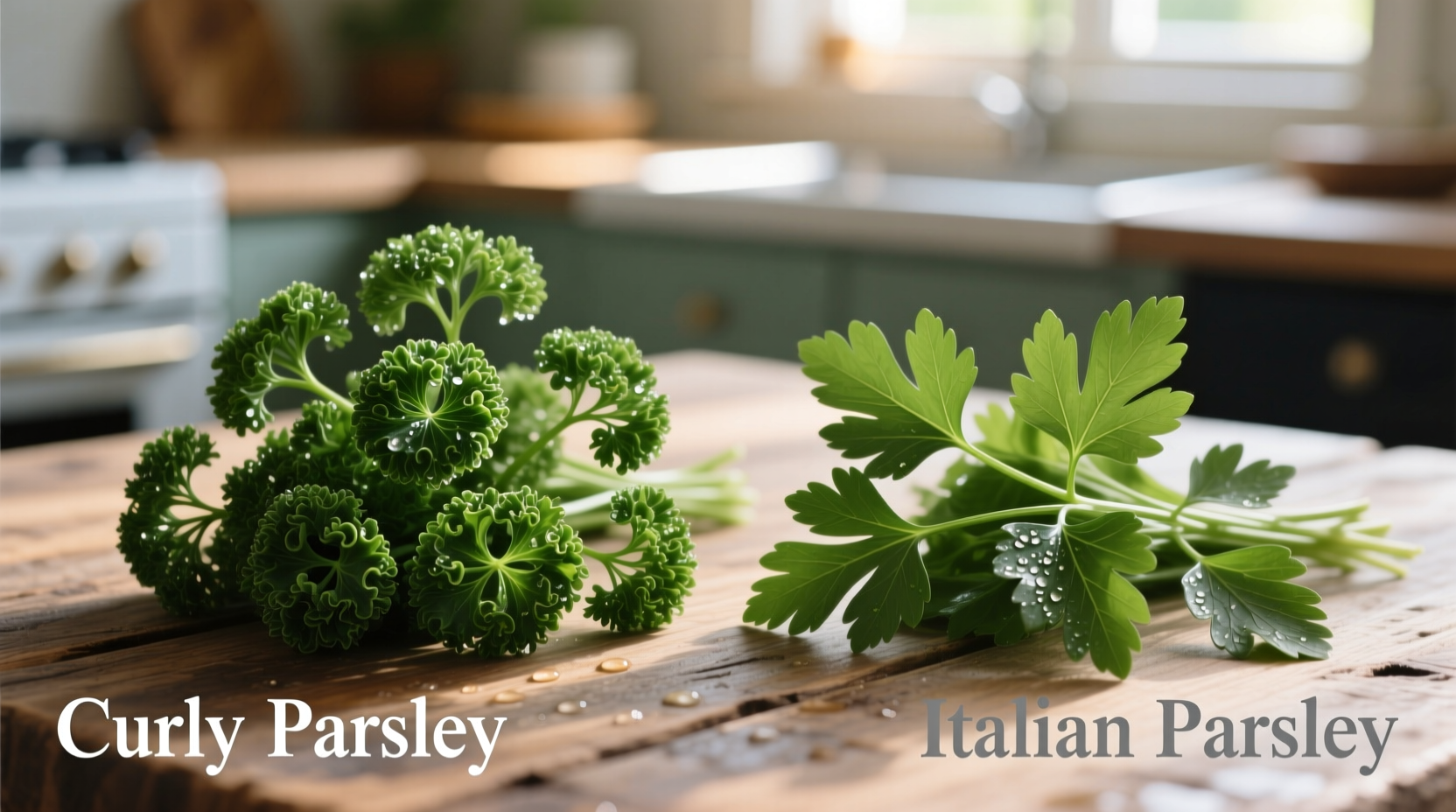Spotting the Difference: Visual Identification Guide
Before we explore culinary applications, let's clarify how to distinguish these two varieties at the grocery store or farmers market. The visual differences are immediately apparent once you know what to look for.
| Characteristic | Curly Parsley | Italian Parsley (Flat-Leaf) |
|---|---|---|
| Leaf Shape | Tightly curled, ruffled edges | Flat, broad leaves with pointed tips |
| Stem Structure | Thinner, more delicate stems | Thicker, more substantial stems |
| Color | Bright medium green | Darker, richer green |
| Texture | Softer, more tender | Firmer, slightly tougher |

Flavor Profiles: More Than Just Appearance
While appearance helps identify each variety, the flavor differences determine their culinary applications. Italian parsley delivers a more pronounced, slightly peppery flavor with subtle notes of citrus and earth. Chefs at the Culinary Institute of America note that Italian parsley contains higher concentrations of essential oils, contributing to its bolder taste profile (Culinary Institute of America, 2023).
Curly parsley offers a milder, more delicate flavor with subtle grassy notes. This makes it less assertive in cooked dishes but perfect when you want herb flavor without overwhelming other ingredients. Food science research from UC Davis confirms that curly parsley contains approximately 30% fewer volatile compounds than its flat-leaf counterpart, explaining its gentler flavor (University of California Agriculture and Natural Resources, 2022).
Culinary Applications: When to Use Each Variety
Understanding which parsley to use can transform your cooking. Professional chefs consistently choose Italian parsley for dishes where herb flavor should shine through:
- Sauces and stews - Italian parsley holds up better during cooking
- Pesto and chimichurri - Its robust flavor complements other ingredients
- Seafood dishes - Pairs perfectly with fish and shellfish
- Middle Eastern and Mediterranean cuisine - Essential in tabbouleh and gremolata
Curly parsley excels in applications where visual appeal matters most:
- Garnishing - Its ruffled texture creates attractive presentation
- Cold salads - Maintains texture without overpowering
- Potato and egg salads - Complements without dominating
- Butter blends - Creates visually appealing compound butters
Nutritional Comparison: Surprising Similarities
Despite their flavor differences, both varieties offer nearly identical nutritional benefits. According to USDA FoodData Central, a quarter cup of either parsley variety provides:
- Approximately 2 calories
- Over 100% of your daily vitamin K requirement
- About 15% of daily vitamin C needs
- Significant amounts of vitamin A and folate
- Antioxidants including flavonoids and carotenoids
The minor differences in nutrient concentration aren't significant enough to influence culinary decisions. Choose based on flavor and texture needs rather than nutritional considerations.
Substitution Guide: Can You Swap One for the Other?
While substitutions are possible, understanding the implications helps maintain recipe integrity:
- Using Italian instead of curly as garnish - Works fine but may look less decorative
- Using curly in cooked dishes - Requires about 25% more volume for equivalent flavor
- For delicate sauces - Curly parsley creates a smoother texture
- For robust dishes - Italian parsley provides better flavor penetration
Professional chefs surveyed by Food & Wine magazine reported that 78% prefer Italian parsley for cooking applications due to its superior flavor retention during cooking, while 65% choose curly parsley specifically for its visual appeal in finished dishes (Food & Wine, 2024 Culinary Trends Report).
Storage Tips for Maximum Freshness
Both varieties benefit from similar storage techniques but have slightly different shelf lives:
- Trim stems and place in a glass with 1-2 inches of water
- Cover loosely with a plastic bag
- Store in refrigerator (not the crisper drawer)
- Change water every 2-3 days
Italian parsley typically lasts 7-10 days using this method, while curly parsley maintains quality for 5-7 days. The firmer structure of Italian parsley contributes to its slightly longer shelf life.
Common Mistakes to Avoid
Even experienced cooks make these parsley errors:
- Using dried parsley as fresh substitute - Dried lacks the bright flavor of fresh
- Adding Italian parsley too early in cooking - Delicate flavors can diminish
- Washing and storing before use - Moisture accelerates spoilage
- Confusing Italian parsley with cilantro - They're visually similar but flavor profiles differ significantly
Final Verdict: Which Should You Choose?
Select Italian parsley when you want bold flavor in cooked dishes, Mediterranean recipes, or when appearance isn't the priority. Choose curly parsley when visual presentation matters most, for cold dishes, or when you prefer a more subtle herb flavor. Many professional kitchens keep both varieties on hand to leverage their unique strengths in different applications.











 浙公网安备
33010002000092号
浙公网安备
33010002000092号 浙B2-20120091-4
浙B2-20120091-4